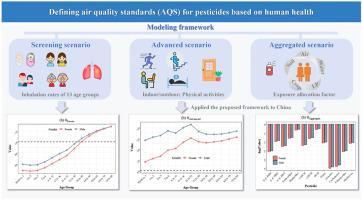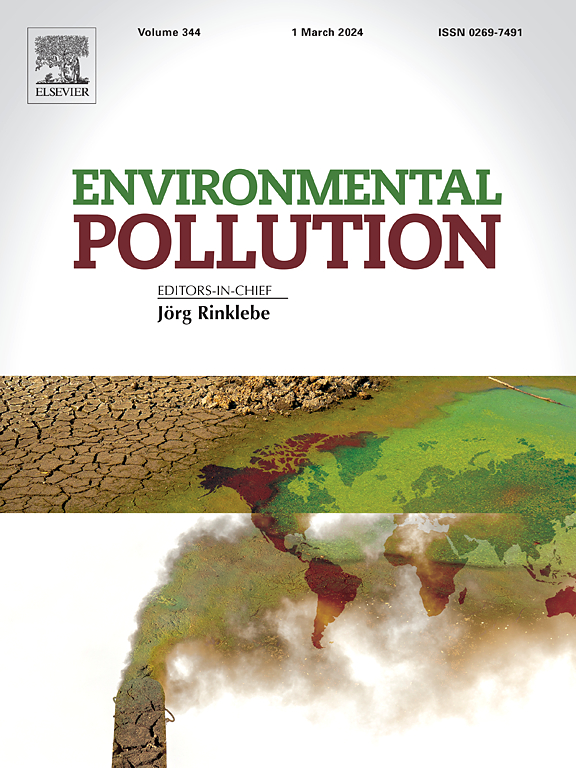通过人口暴露模型确定农药的空气质量标准
IF 7.6
2区 环境科学与生态学
Q1 ENVIRONMENTAL SCIENCES
引用次数: 0
摘要
大气农药污染是危害人类健康的全球性问题。然而,控制空气污染仍然具有挑战性,因为很少有国家建立了农药的空气质量标准(AQS)。在此,我们提出了一个基于人体暴露评估的建模框架,包括筛选、高级和聚合场景。此外,还采用该框架对中国13种农药的空气质量质量进行了模拟。在筛选方案中,暴露评估包括按年龄划分的吸入率。结果显示,各年龄组调整后的暴露系数(θscreening)均小于1,提示推导出的AQSscreening应严格于参考浓度(RfC),以确保各年龄组均有足够的保护。对于高级场景,室外和室内条件以及身体活动水平被纳入暴露评估。结果显示,调整系数(θadv)在所有年龄组均大于1,表明在这种情况下,可以对农药采取更宽松的AQS。对于聚合情景,暴露评估中考虑了人体内暴露源的分配,以确保有足够的安全裕度。结果发现,模拟的调整系数(θadv)一般比1低2 ~ 4个数量级。这个场景可以提供最保守的模拟空气质量。综上所述,该框架可帮助环境部门全面评估人体暴露,并为AQS的推导提供潜在的调整系数。未来的研究建议将与人类暴露有关的更多因素纳入完善框架。本文章由计算机程序翻译,如有差异,请以英文原文为准。

Defining air quality standards for pesticides through population exposure modeling
Atmospheric pesticide pollution is a global problem that poses risks to human health. However, controlling air pollution remains challenging, as few countries have established air quality standards (AQS) for pesticides. Here, we proposed a modeling framework based on human exposure assessment, comprising scenarios: screening, advanced, and aggregated. In addition, the AQSs of 13 selected pesticides in China were simulated using this framework as practice. In the screening scenario, the inhalation rates by age were included in the exposure assessment. The results showed that the adjusted exposure coefficients (θscreening) were below 1 in young age groups, indicating that the derived AQSscreening should be stricter than the reference concentration (RfC) to ensure sufficient protection across all age groups. For the advanced scenario, outdoor and indoor conditions, as well as physical activity levels were incorporated into the exposure assessment. The results revealed that adjusted coefficients (θadv) exceeded 1 at all age groups, suggesting that a more lenient AQS could be appropriated for a pesticide in this scenario. For the aggregated scenario, exposure source allocation within the human body was considered in the exposure assessment to ensure a sufficient safety margin. The result found that the simulated adjusted coefficients (θadv) were generally two to four orders of magnitude below 1. This scenario could provide the most conservative simulated AQSs. In conclusion, the proposed framework can assist environmental agencies in comprehensively assessing human exposure and provide the potential adjusted coefficients for AQS derivation. Future research is recommended to refine the framework with more factors related to human exposure.
求助全文
通过发布文献求助,成功后即可免费获取论文全文。
去求助
来源期刊

Environmental Pollution
环境科学-环境科学
CiteScore
16.00
自引率
6.70%
发文量
2082
审稿时长
2.9 months
期刊介绍:
Environmental Pollution is an international peer-reviewed journal that publishes high-quality research papers and review articles covering all aspects of environmental pollution and its impacts on ecosystems and human health.
Subject areas include, but are not limited to:
• Sources and occurrences of pollutants that are clearly defined and measured in environmental compartments, food and food-related items, and human bodies;
• Interlinks between contaminant exposure and biological, ecological, and human health effects, including those of climate change;
• Contaminants of emerging concerns (including but not limited to antibiotic resistant microorganisms or genes, microplastics/nanoplastics, electronic wastes, light, and noise) and/or their biological, ecological, or human health effects;
• Laboratory and field studies on the remediation/mitigation of environmental pollution via new techniques and with clear links to biological, ecological, or human health effects;
• Modeling of pollution processes, patterns, or trends that is of clear environmental and/or human health interest;
• New techniques that measure and examine environmental occurrences, transport, behavior, and effects of pollutants within the environment or the laboratory, provided that they can be clearly used to address problems within regional or global environmental compartments.
 求助内容:
求助内容: 应助结果提醒方式:
应助结果提醒方式:


